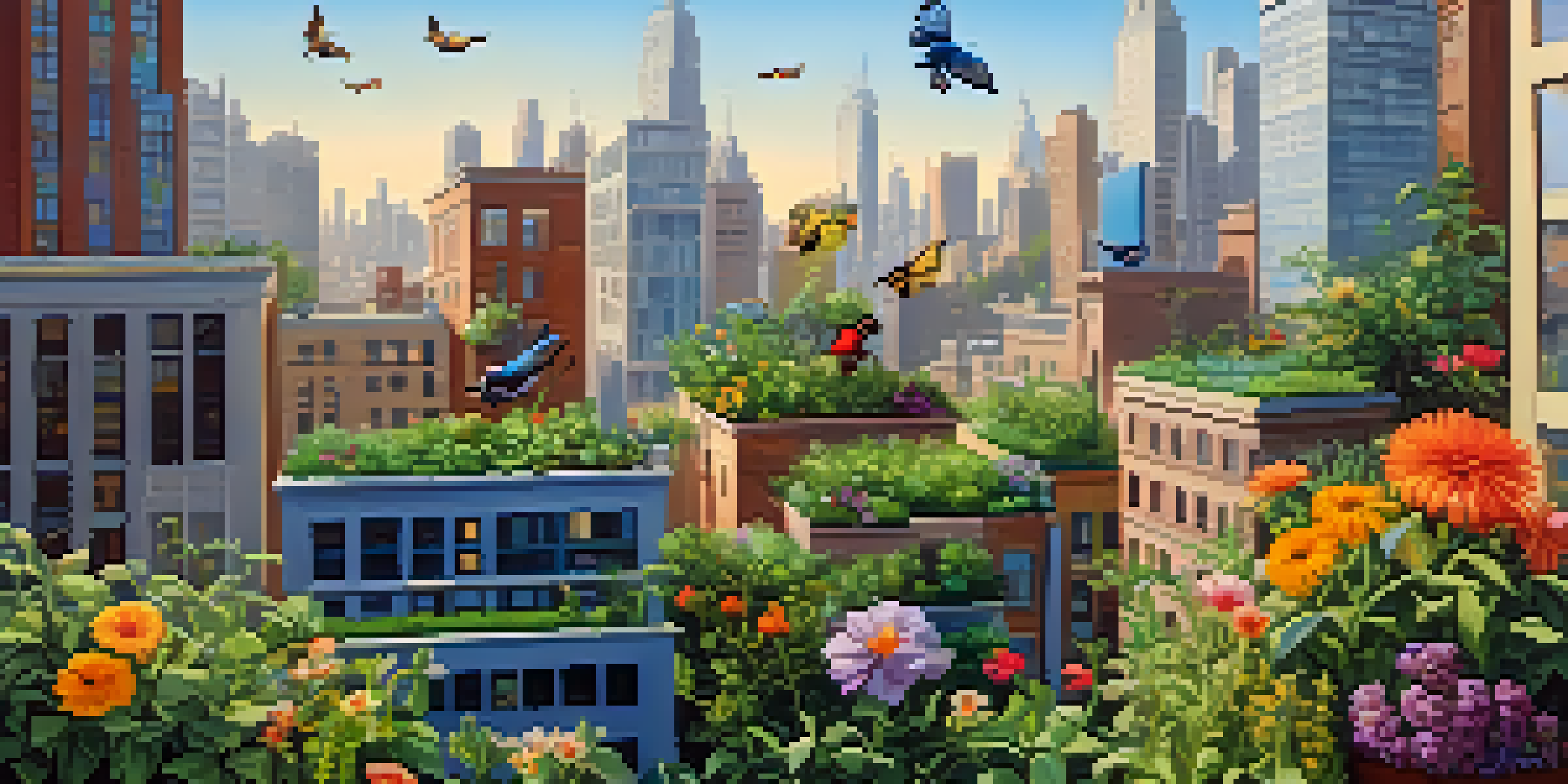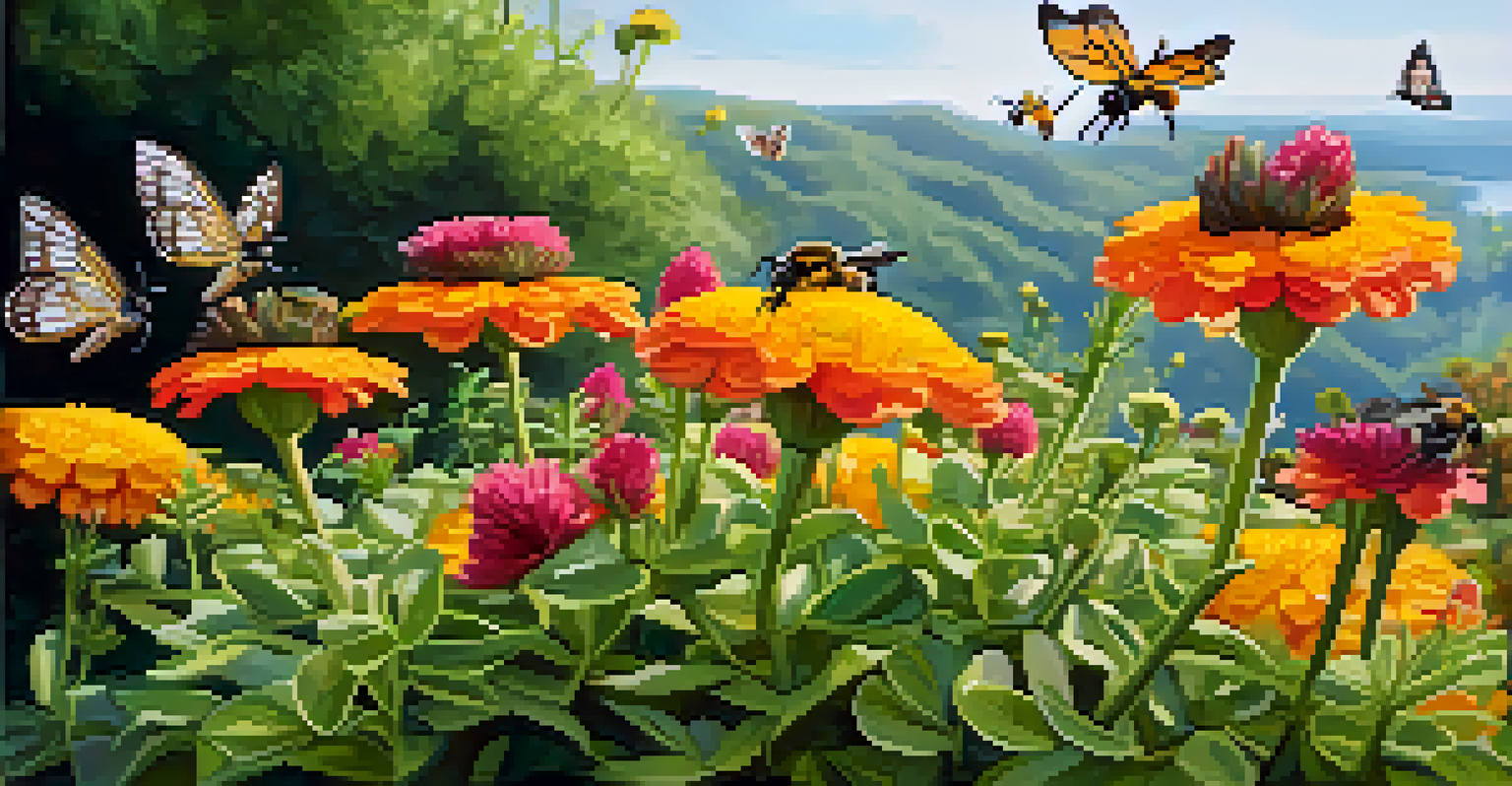Green Roofs and Their Impact on Urban Wildlife

Understanding Green Roofs and Their Design
Green roofs are essentially gardens built on rooftops, consisting of layers that support plant life. They typically include vegetation, a growing medium, and a waterproofing layer to protect the building structure. With their aesthetic appeal and environmental benefits, green roofs are becoming increasingly popular in urban settings.
The greening of cities is not just about aesthetics; it's about creating functional ecosystems that support urban wildlife and improve quality of life.
These roofs not only provide a space for plants but also create a habitat for various wildlife species. By transforming unused spaces into lush green areas, they help mitigate the urban heat island effect, where cities become significantly warmer than their rural surroundings. This cooler environment can encourage more wildlife to thrive in these areas.
Moreover, green roofs can be designed to attract specific wildlife, such as birds and pollinators. By incorporating native plants that provide food and shelter, these roofs can turn ordinary buildings into vibrant ecosystems, promoting biodiversity in densely populated areas.
The Role of Green Roofs in Enhancing Biodiversity
Biodiversity refers to the variety of life in a particular habitat, and urban areas often lack this variety. Green roofs serve as an oasis for many species, providing essential resources like food and nesting sites. This helps to create a more balanced ecosystem within cities, which is crucial for maintaining healthy environmental interactions.

For example, a green roof can support various insects, such as bees and butterflies, which are vital for pollination. The presence of these pollinators not only aids plants in reproducing but also ensures that urban gardens and parks flourish. This interconnectedness highlights the importance of green roofs in supporting overall urban biodiversity.
Green Roofs Boost Urban Biodiversity
Green roofs create vital habitats for wildlife, enhancing biodiversity in urban areas by providing food and nesting sites.
Furthermore, green roofs can act as stepping stones for migratory species, allowing them to rest and refuel during their journeys. By preserving and enhancing these habitats, cities can become crucial players in the conservation of various wildlife species that may be threatened by urbanization.
Mitigating Urban Heat and Its Effects on Wildlife
Urban heat islands can significantly impact wildlife, as higher temperatures can disrupt habitats and food sources. Green roofs help combat this phenomenon by providing a cooling effect, which benefits both flora and fauna. The vegetation absorbs sunlight and reduces heat absorption by buildings, creating a more hospitable environment for wildlife.
Nature does not hurry, yet everything is accomplished.
As temperatures rise, many species struggle to adapt, leading to declines in populations. Green roofs can serve as climate refuges, allowing species to find cooler microclimates amidst the heat of the city. This adaptability can be crucial for the survival of urban wildlife, particularly during extreme weather events.
In addition to cooling the environment, green roofs can also manage stormwater runoff, which is vital for maintaining healthy ecosystems. By absorbing rainwater and reducing flooding, these roofs help create a stable environment for the wildlife that relies on these urban habitats.
Improving Air Quality for Urban Wildlife
Air pollution is a significant concern in urban areas, negatively affecting both human and wildlife health. Green roofs play a pivotal role in improving air quality by filtering pollutants and absorbing carbon dioxide. This cleaner air not only benefits the residents of the city but also contributes to healthier habitats for various species.
Plants on green roofs can absorb harmful gases, such as nitrogen dioxide and sulfur dioxide, helping to purify the air. This creates a more favorable environment for sensitive wildlife, including birds and insects, that might otherwise struggle in polluted conditions. The presence of cleaner air is essential for the overall health of urban ecosystems.
Combatting Urban Heat Effects
By reducing temperatures and managing stormwater, green roofs help mitigate the urban heat island effect, benefiting both flora and fauna.
Moreover, the biodiversity on green roofs contributes to air quality improvements, as diverse plant species can capture different types of pollutants. The synergy between plant diversity and wildlife health showcases the importance of integrating green roofs into urban planning.
Providing Habitat for Pollinators and Birds
Pollinators like bees and butterflies are crucial to the ecosystem, helping to ensure the reproduction of many plant species. Green roofs can provide a sanctuary for these important insects, offering them a variety of flowering plants that bloom throughout different seasons. This can lead to increased pollinator populations in urban areas, which is beneficial for both nature and agriculture.
Birds also benefit from green roofs, as they provide nesting sites and food sources in an otherwise barren urban landscape. By incorporating native plants that produce seeds and berries, green roofs can attract a diversity of bird species. In turn, these birds can help control pest populations, creating a healthier balance within the ecosystem.
Creating habitats for both pollinators and birds not only enhances biodiversity but also fosters a greater connection between urban residents and the wildlife around them. It encourages people to appreciate the importance of preserving these species and their habitats.
The Economic Benefits of Green Roofs for Wildlife
While the ecological benefits of green roofs are clear, they also offer economic advantages that can indirectly support urban wildlife. Green roofs can enhance property values by providing aesthetic appeal and increasing energy efficiency. Homeowners and businesses alike can benefit from lower energy bills, which can create a positive feedback loop for maintaining these green spaces.
Moreover, green roofs can reduce stormwater management costs for municipalities by decreasing the burden on drainage systems. This can free up funding for other environmental initiatives, including wildlife conservation programs. By investing in green infrastructure, cities can create a more sustainable urban environment that benefits both residents and wildlife.
Economic Gains from Green Roofs
In addition to ecological benefits, green roofs enhance property values and reduce municipal stormwater costs, supporting urban wildlife indirectly.
Additionally, the presence of green roofs can attract eco-tourism and promote local businesses, creating new economic opportunities. This not only fosters a culture of sustainability but also raises awareness about the importance of protecting urban wildlife, ultimately leading to more resources dedicated to conservation efforts.
Challenges and Future of Green Roofs in Urban Areas
Despite their many benefits, green roofs face challenges in urban environments, such as high installation costs and maintenance requirements. These factors can deter building owners and developers from investing in green roofs. However, as awareness of the ecological benefits grows, so too does the availability of funding and incentives for green infrastructure projects.
Community involvement is crucial for the success of green roofs. Engaging local residents in the planning and maintenance of these spaces can foster a sense of ownership and responsibility, encouraging long-term sustainability. Education programs about the benefits of green roofs can also cultivate a culture of appreciation for urban wildlife.

Looking ahead, the future of green roofs seems promising as cities continue to prioritize sustainability. With advancements in technology and design, we can expect to see more innovative green roofs that support urban wildlife while enhancing the quality of life for city residents.